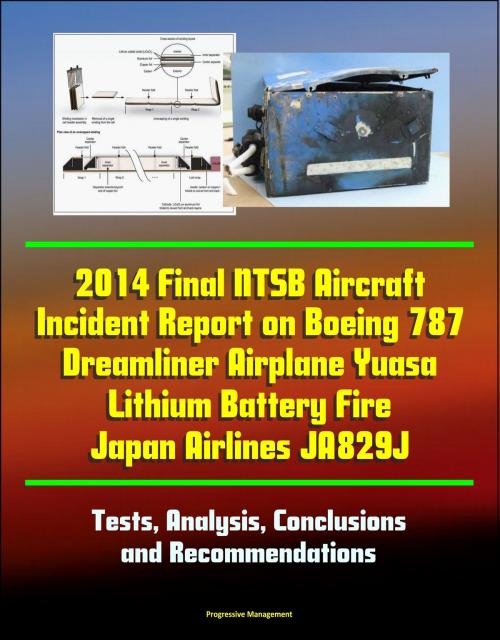2014 Final NTSB Aircraft Incident Report on Boeing 787 Dreamliner Airplane Yuasa Lithium Battery Fire Japan Airlines JA829J: Tests, Analysis, Conclusions and Recommendations
Nonfiction, Science & Nature, Technology, Electricity, Aeronautics & Astronautics| Author: | Progressive Management | ISBN: | 9781311288639 |
| Publisher: | Progressive Management | Publication: | December 6, 2014 |
| Imprint: | Smashwords Edition | Language: | English |
| Author: | Progressive Management |
| ISBN: | 9781311288639 |
| Publisher: | Progressive Management |
| Publication: | December 6, 2014 |
| Imprint: | Smashwords Edition |
| Language: | English |
This ebook provides the complete National Transportation Safety Board (NTSB) Aircraft Incident Report issued in November 2014 (plus a full compilation of documents and additional information) about the fires and smoke incidents involving lithium-ion batteries on Boeing 787 Dreamliner commercial airplanes in 2013. This report discusses the January 7, 2013, incident involving a Japan Airlines Boeing 787-8, JA8297, which was parked at a gate at General Edward Lawrence Logan International Airport, Boston, Massachusetts, when maintenance personnel observed smoke coming from the lid of the auxiliary power unit battery case, as well as a fire with two distinct flames at the electrical connector on the front of the case. No passengers or crewmembers were aboard the airplane at the time, and none of the maintenance or cleaning personnel aboard the airplane was injured. Safety issues relate to cell internal short circuiting and the potential for thermal runaway of one or more battery cells, fire, explosion, and flammable electrolyte release; cell manufacturing defects and oversight of cell manufacturing processes; thermal management of large-format lithium-ion batteries; insufficient guidance for manufacturers to use in determining and justifying key assumptions in safety assessments; insufficient guidance for Federal Aviation Administration (FAA) certification engineers to use during the type certification process to ensure compliance with applicable requirements; and stale flight data and poor-quality audio recording of the 787 enhanced airborne flight recorder. Safety recommendations are addressed to the FAA, The Boeing Company, and GS Yuasa Corporation.
Executive Summary * 1. Factual Information * 1.1 Event History * 1.2 Airplane Information * 1.2.1 Battery Information * 1.2.2 Battery and Related Component Information * 1.2.3 Postincident Airplane Examination * 1.2.4 Additional Airplane-Related Information * 1.3 Flight Recorders * 1.4 Incident Battery Examinations * 1.4.1 External Observations * 1.4.2 Radiographic Examinations of Incident Battery and Cells * 1.4.3 Disassembly of Incident Battery * 1.4.4 Battery Case Protrusion and Corresponding Cell Case Damage * 1.4.5 Disassembly of Incident Battery Cells * 1.5 Exemplar Battery Examinations and Testing * 1.5.1 Radiographic Examinations of Exemplar Battery Cells * 1.5.2 Cell Soft-Short Tests * 1.5.3 Examinations of Cells From the Incident Airplane Main Battery * 1.5.4 Cell-Level Abuse Tests * 1.5.5 Rivet Observations During Cell- and Battery-Level Testing * 1.5.6 Cold Temperature Cell- and Battery-Level Testing * 1.5.7 Battery-Level Nail Penetration Tests * 1.5.8 Additional Testing * 1.6 Battery Manufacturing Information * 1.6.1 Main and Auxiliary Power Unit Battery Development * 1.6.2 Cell Manufacturing Process * 1.7 System Safety and Certification * 1.7.1 Type Certification Overview and Battery Special Conditions * 1.7.2 Certification Plan * 1.7.3 System Safety Assessment * 1.8 Additional Information * 1.8.1 Federal Aviation Administration Actions After Battery Incidents * 1.8.2 Previously Issued Safety Recommendations * 2. Analysis * 2.1 Failure Sequence * 2.2 Emergency Response * 2.3 Cell Manufacturing Concerns * 2.4 Thermal Management of Large-Format Lithium-Ion Batteries * 2.4.1 Battery Internal Heating During High-Current Discharge * 2.4.2 Cell-Level Temperature and Voltage Monitoring * 2.4.3 Thermal Safety Limits for Cells * 2.5 Certification Process * 2.5.1 Validation of Assumptions and Data Used in Safety Assessments Involving New Technology * 2.5.2 Validating Methods of Compliance for Designs Involving New Technology * 2.5.3 Certification of Lithium-ion Batteries and Certification of New Technology * 2.6 Flight Recorder Issues * 2.6.1 Stale Flight Data * 2.6.2 Poor-Quality Cockpit Voice Recording * 3. Conclusions * 3.1 Findings * 3.2 Probable Cause * 4. Recommendations
This ebook provides the complete National Transportation Safety Board (NTSB) Aircraft Incident Report issued in November 2014 (plus a full compilation of documents and additional information) about the fires and smoke incidents involving lithium-ion batteries on Boeing 787 Dreamliner commercial airplanes in 2013. This report discusses the January 7, 2013, incident involving a Japan Airlines Boeing 787-8, JA8297, which was parked at a gate at General Edward Lawrence Logan International Airport, Boston, Massachusetts, when maintenance personnel observed smoke coming from the lid of the auxiliary power unit battery case, as well as a fire with two distinct flames at the electrical connector on the front of the case. No passengers or crewmembers were aboard the airplane at the time, and none of the maintenance or cleaning personnel aboard the airplane was injured. Safety issues relate to cell internal short circuiting and the potential for thermal runaway of one or more battery cells, fire, explosion, and flammable electrolyte release; cell manufacturing defects and oversight of cell manufacturing processes; thermal management of large-format lithium-ion batteries; insufficient guidance for manufacturers to use in determining and justifying key assumptions in safety assessments; insufficient guidance for Federal Aviation Administration (FAA) certification engineers to use during the type certification process to ensure compliance with applicable requirements; and stale flight data and poor-quality audio recording of the 787 enhanced airborne flight recorder. Safety recommendations are addressed to the FAA, The Boeing Company, and GS Yuasa Corporation.
Executive Summary * 1. Factual Information * 1.1 Event History * 1.2 Airplane Information * 1.2.1 Battery Information * 1.2.2 Battery and Related Component Information * 1.2.3 Postincident Airplane Examination * 1.2.4 Additional Airplane-Related Information * 1.3 Flight Recorders * 1.4 Incident Battery Examinations * 1.4.1 External Observations * 1.4.2 Radiographic Examinations of Incident Battery and Cells * 1.4.3 Disassembly of Incident Battery * 1.4.4 Battery Case Protrusion and Corresponding Cell Case Damage * 1.4.5 Disassembly of Incident Battery Cells * 1.5 Exemplar Battery Examinations and Testing * 1.5.1 Radiographic Examinations of Exemplar Battery Cells * 1.5.2 Cell Soft-Short Tests * 1.5.3 Examinations of Cells From the Incident Airplane Main Battery * 1.5.4 Cell-Level Abuse Tests * 1.5.5 Rivet Observations During Cell- and Battery-Level Testing * 1.5.6 Cold Temperature Cell- and Battery-Level Testing * 1.5.7 Battery-Level Nail Penetration Tests * 1.5.8 Additional Testing * 1.6 Battery Manufacturing Information * 1.6.1 Main and Auxiliary Power Unit Battery Development * 1.6.2 Cell Manufacturing Process * 1.7 System Safety and Certification * 1.7.1 Type Certification Overview and Battery Special Conditions * 1.7.2 Certification Plan * 1.7.3 System Safety Assessment * 1.8 Additional Information * 1.8.1 Federal Aviation Administration Actions After Battery Incidents * 1.8.2 Previously Issued Safety Recommendations * 2. Analysis * 2.1 Failure Sequence * 2.2 Emergency Response * 2.3 Cell Manufacturing Concerns * 2.4 Thermal Management of Large-Format Lithium-Ion Batteries * 2.4.1 Battery Internal Heating During High-Current Discharge * 2.4.2 Cell-Level Temperature and Voltage Monitoring * 2.4.3 Thermal Safety Limits for Cells * 2.5 Certification Process * 2.5.1 Validation of Assumptions and Data Used in Safety Assessments Involving New Technology * 2.5.2 Validating Methods of Compliance for Designs Involving New Technology * 2.5.3 Certification of Lithium-ion Batteries and Certification of New Technology * 2.6 Flight Recorder Issues * 2.6.1 Stale Flight Data * 2.6.2 Poor-Quality Cockpit Voice Recording * 3. Conclusions * 3.1 Findings * 3.2 Probable Cause * 4. Recommendations















